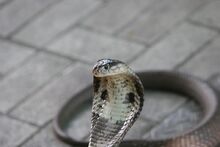
The monocled cobra (Naja kaouthia), also called monocellate cobra, is a cobra species, which is widespread across South and South East Asia and listed as Least Concern by IUCN.
The monocled cobra has an O-shaped, or monocellate hood pattern, unlike that of the Indian cobra which has the "spectacle" pattern (2 circular ocelli connected by a curved line) on the rear of its hood. Coloration in the young is more constant. The dorsal surface may be yellow, brown, gray, or blackish, with or without ragged or clearly defined cross bands. It can be olivaceous or brownish to black above with or without a yellow or orange-colored, O-shaped mark on the hood. It has a black spot on the lower surface of the hood on either side, and one or two black cross-bars on the belly behind it. The rest of the belly is usually of the same color as the back, but paler. As age advances, the snake becomes paler, wherein the adult is brownish or olivaceous. The elongated nuchal ribs enable a cobra to expand the anterior of the neck into a “hood”. A pair of fixed anterior fangs is present. The largest fang recorded measured 6.78 mm (0.678 cm). Fangs are moderately adapted for spitting. Adult monocled cobras reach a length of 1.35 to 1.5 m (4.4 to 4.9 ft) with a tail length of 23 cm (9.1 in). Many larger specimens have been recorded, but they are rare. Adults can reach a maximum of 2.3 m (7.5 ft) in length.
They have 25 to 31 scales on the neck, 19 to 21, usually 21, on the body, and 17 or 15 on the front of the vent. They have 164 to 197 ventral scales and 43 to 58 subcaudal scales.
Monocled cobras tend to have more than one cuneate scale on each side. The shape of the frontal scale is short and square. Ventrals in males range from 170 to 192, in females from 178 to 197. Subcaudals in males range from 48 to 61, in females from 46 to 59.
Monocled cobras are distributed from India in the west through to China, Vietnam and Cambodia. They are also found on the Malay Peninsula and are native to Bangladesh, Bhutan, Myanmar, Laos, Nepal, and Thailand.
These cobras can adapt to a range of habitats, from natural to anthropogenically impacted environments. They prefer habitats associated with water, such as paddy fields, swamps, and mangroves, but can also be found in grasslands, shrublands, and forests. The species also occurs in agricultural land and human settlements, including cities. They can be found at elevations of up to 1,000 m (3,300 ft) above sea level.
Monocled cobras are terrestrial and most active at dusk and in the evening. In rice-growing areas, they hide in rodentburrows in the dykes between fields and have become semi-aquatic in this type of habitat. Juveniles feed mostly on amphibians, and adults prey on small mammals, snakes and fish. When disturbed they prefer to take flight. However, when threatened, they will raise the anterior portions of their bodies, spread their hood, usually hiss loudly, and strike in an attempt to bite and defend themselves.
They are often found in tree holes and areas where rodents are plentiful.
This is an oviparous species. Females lay between 16 and 33 eggs per clutch. Incubation periods range from 55 to 73 days. Egg-laying takes place in January to March. The females usually stay with the eggs. Some collaboration between males and females has been reported in Naja naja x Naja kaouthia - hybrids.
This species has been assessed as Least Concern by IUCN owing to its large distribution, tolerance of a broad range of habitats, including anthropogenically altered environments, and its reported abundance. No major threats have been reported, and the species is not thought to be undergoing a significant population decline. In places the distribution of this species coincides with protected areas, probably providing small safeguards. Monocled cobras are harvested for the skin trade, however, collection from the wild is minimal and not likely to be causing significant population declines. Naja kaouthia is listed on CITES Appendix II.
The Naja kaouthia venom sources from three different localities were reported to exhibit different intravenous and subcutaneous median lethal dose: Thailand, 0.18-0.22 µg/g; Malaysia, 0.90-1.11 µg/g; and Vietnam, 0.90-1.00 µg/g, of mouse body weight. The proteomics finding revealed that the neurotoxin profiles of these Naja kaouthia were substantially different, reflecting the distinct difference in their lethal potency and response to antivenom neutralization.
The major toxic components in cobra venoms are postsynaptic neurotoxins, which block the nerve transmission by binding specifically to the nicotinic acetylcholine receptor, leading to flaccid paralysis and even death by respiratory failure. The major α-neurotoxin in Naja kaouthia venom is a long neurotoxin, α-cobratoxin; the minor α-neurotoxin is different from cobrotoxin in one residue. The neurotoxins of this particular species are weak. The venom of this species also contains myotoxins and cardiotoxins.
In case of intravenous injection the LD50 tested in mice is 0.373 mg/kg, and 0.225 mg/kg in case of intraperitoneal injection. The average venom yield per bite is approximately 263 mg (dry weight).
The monocled cobra causes the highest fatality due to snake venom poisoning in Thailand. Envenomation usually presents predominantly with extensive local necrosis and systemic manifestations to a lesser degree. Drowsiness, neurological and neuromuscular symptoms will usually manifest earliest; hypotension, flushing of the face, warm skin, and pain around bite site typically manifest within one to four hours following the bite; paralysis, ventilatory failure or death could ensue rapidly, possibly as early as 60 minutes in very severe cases of envenomation. However, the presence of fang marks does not always imply that envenomation actually occurred.
Extract of Mimosa pudica plant has been shown, in a preliminary study, to possibly have neutralizing effects on the toxins present in this venom.
